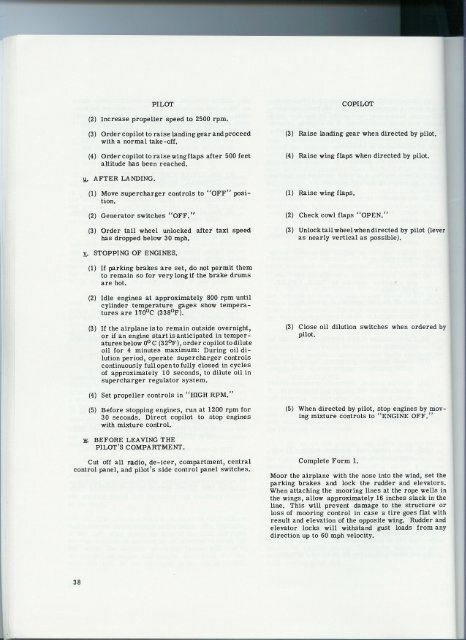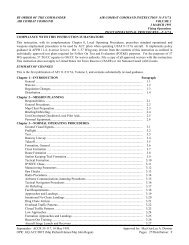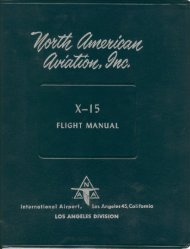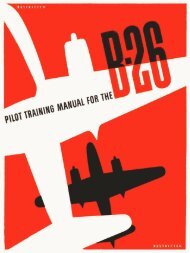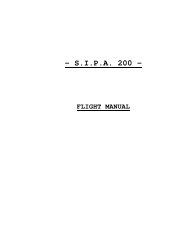B-17 Pilots Manual.pdf
B-17 Pilots Manual.pdf
B-17 Pilots Manual.pdf
You also want an ePaper? Increase the reach of your titles
YUMPU automatically turns print PDFs into web optimized ePapers that Google loves.
J:PILarCOPILar(2) Increase propeller speed to 2500 rpm.(3) Order copilot to raise landing gear and proceedwith a normal take -off.(4) Order copilot to raise wing flaps after 500 feetaltitude has been reached.(3) Raise landing gear when directed by pilot.(4) Raise wing flaps when directed by pilot.y.. AFTERLANDING.(1) Move supercharger controls to "OFF" position.(2) Generator switches "OFF."(3) Order tail wheel unlocked after taxi speedrulS dropped below 30 mph.(1) Raise wing flaps.(2) Check cowl flaps "OPEN."(3) Unlock tail wheel when directed by pilot (leveras nearly vertical as possible).y. STOPPING OF ENGINES.(1) If parking brakes are set, do not permit themto remain so for very long if the brake drumsare hot..J(2) Idle engines at approximately 800 rpm untilcylinder temperature gages show temperaturesare <strong>17</strong>00C (3380F).(3) If the airplane is to remain outside overnight,or if an engine start is anticipated in temperaturesbelow 00 C (32~), order copilot to diluteoil for 4 minutes maximum: During oil dilutionperiod, operate supercharger controlscontinuously full open to fully closed in cyclesof approximately 10 seconds, to dilute oil insupercharger regulator system.(3) Close oil dilution switches when ordered bypilot.(4) Set propeller controls in "IllGH RPM."(5) Before stopping engines, run at 1200 rpm for30 seconds. Direct copilot to stop engineswith mixture control.(5) When directed by pilot, stop engines by movingmixture controls to "ENGINE OFF."Yi. BEFOREPILar'SLEAVING THECOMPARTMENT.Cut off all radio, de-icer, compartment, centralcontrol panel, and pilot's side control panel switches.Complete Form 1.Moor the airplane with the nose into the wind, set theparking brakes and lock the rudder and elevators.When attaching the mooring lines at the rope wells inthe wings, allow approximately 16 inches slack in theline. This will prevent damage to the structure orloss of mooring control in case a tire goes flat withresult and elevation of the opposite wing. Rudder andelevator locks will withstand gust loads from anydirection up to 60 mph velocity.38


